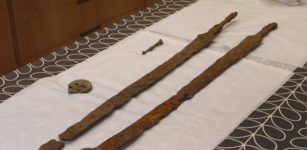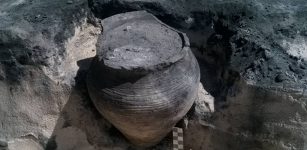Gigantic Karnak Temple Complex: Advanced Ancient Technology In Egypt
A. Sutherland - AncientPages.com - Almost no other site in Egypt is more impressive and fascinating than Karnak.
Karnak Temples at Luxor as seen from the air. Credit: Ahmed Bahloul Khier Galal - CC BY-SA 4.0
Karnak represents one of the most outstanding temple complexes in the world. It results from the combined architectural achievements of several generations of skilled ancient builders of Pharaonic Egypt.
Karnak Was Built With Advanced Ancient Technology
"Construction continued on the temple for thirteen hundred years under approximately thirty different pharaohs. The sheer volume of granite, diorite, and alabaster cut precisely into statues around Luxor attest to the ancient Egyptians' mastery of their craft.
The Greeks and Romans did not sculpt statues in igneous rock," writes Christopher Dunn in his book "Lost Technologies of Ancient Egypt: Advanced Engineering in the Temples of the Pharaohs."
According to Dunn, these achievements would be impossible without taking precise measurements. The unique geometry and precision of ancient Egyptian monuments, structures, and artifacts display incredible symmetry, size, and perfection that, even today, are among the most difficult on earth to obtain.
Karnak, Great Hall. William Henry Goodyear (1846–1923). Credit: Public Domain
Another architectural wonder is an obelisk (one of four that survived) erected by Queen Hatshepsut. It is 97 feet tall and weighs about 320 tons or even more.
Worth noting is that a 'smaller' obelisk was erected by Tuthmosis I (1504 - 1492 BC). It is 75 feet high, has sides 6 feet wide at its base, and weighs between 143 and 160 tons. The inscription at its base informs that cutting the monolith out of the quarry required seven months of labor.
How were these enormous pieces of stone transported from distant Aswan?
Karnak Has Still Not Revealed All Of Its Ancient Secrets
Karnak covers an impressive area of about 3 km (175 miles) and is located north of the modern city of Hatsh. The thriving town of Thebes surrounded it.
The huge obelisk is clearly visible. Credit: Marc Ryckaert - CC BY-SA 4.0
It takes a few hours to walk and look at the historical complex, but it is worth staying until the evening to see the magnificent spectacle of the "light and sound" arranged within the walls of the complex.
The ancient name of this place was "Ipet-Isut" ("The Most Select of Places"). It was the seat of the great god Amun-Re, accompanied by temples and chapels dedicated to other Egyptian deities. It was the main shrine in the land of the pharaohs.
Karnak is considered the largest temple in the world, equaled only by the famous Angkor Wat in Cambodia.
The Karnak Temple Complex, commonly known as Karnak meaning "fortified village", comprises a vast mix of decayed temples, chapels, pylons, and other buildings. Credit: Adobe Stock - alipko
Karnak, which today's name derives from the neighboring village of el-Karnak, is composed of three main compounds. The first, located in the center, is the precinct of Amun-Re with several minor temples; the next is the precinct of Amun's consort, Mut, a self-created goddess "who giveth birth, but was herself not born of any."
To the north is the smallest precinct of Montu, the falcon-headed god of war, "Lord of Thebes." Karnak offers much to see, with a spectacular collection of obelisks, stone statues, gigantic walls, and walls.
One masterwork is the Hypostyle Hall in the Precinct of Amun-Re, a hall area of 50,000 sq ft (5,000 m2) with 134 gigantic columns arranged in 16 rows. One hundred twenty-two columns are 10 meters tall, and the other 12 are 21 meters tall with a diameter of over three meters. The architraves on top of these columns weigh about 70 tons.
Alley of sphinxes. Credit: Janusz Reclaw - CC BY-SA 3
Another one is the 2,700 meters long and 76 meters wide Avenue of Sphinxes, connecting the Luxor and Karnak temples.
Built by the 30th Dynasty king Nectanebo I (380-362 BC), the avenue is lined with several statues depicting sphinxes. On the route of this avenue, Queen Hatshepsut (1473 -1458 BC) built six chapels dedicated to the god Amun-Re and recorded this event in her red chapel in Karnak temple.
Karnak has still not revealed all its secrets; most of the original temple complex is still hidden under the city of Luxor and is inaccessible by archaeologists.
One of many still-kept secrets is what kind of methods builders used to achieve their colossal work.
In 2010, archaeologists unearthed a 3,500-year-old door to the afterlife near the temple in Karnak. Archaeologists believe it is a false door designed to allow the deceased and his wife to interact with the world of the living.
Such niches were found in nearly all ancient Egyptian tombs. The six-foot-tall (1.75 meters) slab of pink granite was decorated with religious texts. The idea was to take the spirits of the dead to and from the afterworld.
Hypostyle hall of the Precinct of Amun-Re, as it appeared in 1838 in The Holy Land, Syria, Idumea, Arabia, Egypt, and Nubia. Image credit: David Roberts RA, artist and Haghe, Louis, 1806-1885, lithographer - Public Domain
The door came from the tomb of User, the chief minister of Queen Hatshepsut, a powerful, long-ruling 15th century BC. Queen from the New Kingdom, a famous mortuary temple near Luxor in southern Egypt.
Built over long construction periods and systematic enlargements from around 2055 BC to 395 AD, Karnak finally lost its power.
In 323 AD, Constantine the Great recognized the Christian religion, and in 356, Constantius II ordered the closing of pagan temples throughout the empire. Karnak was, by this time, mostly abandoned, and Christian churches were built among the ruins. The Festival Hall of Thutmose III still has well-preserved depictions of saints and Coptic inscriptions.
Written by – A. Sutherland AncientPages.com Staff Writer
Updated on January 22, 2022
Copyright © AncientPages.com All rights reserved. This material may not be published, broadcast, rewritten or redistributed in whole or part without the express written permission of AncientPages.com
Expand for referencesMore From Ancient Pages
-
 Mysterious Sumerian Queen Puabi And Her Magnificent Underground Burial Complex – Many Followed Her To Afterlife
Featured Stories | Oct 20, 2016
Mysterious Sumerian Queen Puabi And Her Magnificent Underground Burial Complex – Many Followed Her To Afterlife
Featured Stories | Oct 20, 2016 -
 Notre Dame Is On Fire! Can The Magnificent Cathedral Still Be Saved?
News | Apr 15, 2019
Notre Dame Is On Fire! Can The Magnificent Cathedral Still Be Saved?
News | Apr 15, 2019 -
 Galileo Galilei Wrote A Controversial Astronomical Treatise Using A Pseudonym
News | Oct 6, 2022
Galileo Galilei Wrote A Controversial Astronomical Treatise Using A Pseudonym
News | Oct 6, 2022 -
 Forbidden Ancient Manuscripts Almost Erased From History – Unusual Myths, Beliefs And Practices – Part 2
Ancient Mysteries | May 11, 2018
Forbidden Ancient Manuscripts Almost Erased From History – Unusual Myths, Beliefs And Practices – Part 2
Ancient Mysteries | May 11, 2018 -
 Explore The Giant Gjellestad Viking Ship Burial In This Stunning Virtual Tour
Featured Stories | Apr 6, 2020
Explore The Giant Gjellestad Viking Ship Burial In This Stunning Virtual Tour
Featured Stories | Apr 6, 2020 -
 Royal Tombs Of Alexander The Great’s Family At Vergina, Greece Finally Identified
Archaeology | Jan 31, 2024
Royal Tombs Of Alexander The Great’s Family At Vergina, Greece Finally Identified
Archaeology | Jan 31, 2024 -
 Sacred Bird Garuda And Stealing Of Amrita Drink Of Immortality From The Gods
Featured Stories | Jun 5, 2019
Sacred Bird Garuda And Stealing Of Amrita Drink Of Immortality From The Gods
Featured Stories | Jun 5, 2019 -
 Ancestral Māori Adapted Quickly In The Face Of Rapid Climate Change – New Study Shows
Archaeology | Nov 10, 2022
Ancestral Māori Adapted Quickly In The Face Of Rapid Climate Change – New Study Shows
Archaeology | Nov 10, 2022 -
 Earliest Document Written 2,100 Years Ago May Rewrite History Of The Basque Language
Archaeology | Nov 17, 2022
Earliest Document Written 2,100 Years Ago May Rewrite History Of The Basque Language
Archaeology | Nov 17, 2022 -
 Unique Ancient Roman Cavalry Swords Found In Cotswolds, UK
Archaeology | Sep 18, 2023
Unique Ancient Roman Cavalry Swords Found In Cotswolds, UK
Archaeology | Sep 18, 2023 -
 Controversial Prehistoric Structures That Resisted Water And Extreme Weather Conditions
Ancient Mysteries | Jun 27, 2018
Controversial Prehistoric Structures That Resisted Water And Extreme Weather Conditions
Ancient Mysteries | Jun 27, 2018 -
 Ancient City Of Gordium, Gordian Knot And Skeleton In Tumulus Of King Midas
Civilizations | Sep 20, 2018
Ancient City Of Gordium, Gordian Knot And Skeleton In Tumulus Of King Midas
Civilizations | Sep 20, 2018 -
 Ancient DNA Pushes Herring Trade Back To The Viking Age
Archaeology | Oct 26, 2022
Ancient DNA Pushes Herring Trade Back To The Viking Age
Archaeology | Oct 26, 2022 -
 Sampul Tapestry: Mysterious Silk Road Textile Linked To Hellenistic Kingdoms Of Central Asia And Tarim Basin
Artifacts | Nov 21, 2018
Sampul Tapestry: Mysterious Silk Road Textile Linked To Hellenistic Kingdoms Of Central Asia And Tarim Basin
Artifacts | Nov 21, 2018 -
 Yuki-Onna ‘Lady Of The Snow’: A Female Demon And Symbol Of Death In Japanese Mythology
Featured Stories | Mar 7, 2019
Yuki-Onna ‘Lady Of The Snow’: A Female Demon And Symbol Of Death In Japanese Mythology
Featured Stories | Mar 7, 2019 -
 Ancient Objects Used In Unknown Celtic Ritual Discovered In Polish Lake
Archaeology | Jul 22, 2024
Ancient Objects Used In Unknown Celtic Ritual Discovered In Polish Lake
Archaeology | Jul 22, 2024 -
 On This Day In History: William Laud Archbishop Of Canterbury Beheaded – On Jan 10, 1645
News | Jan 10, 2017
On This Day In History: William Laud Archbishop Of Canterbury Beheaded – On Jan 10, 1645
News | Jan 10, 2017 -
 Extraordinary Discovery: Clay Vessel With Sour Soup For The Gods Found In Medieval Hut
Archaeology | Jun 4, 2017
Extraordinary Discovery: Clay Vessel With Sour Soup For The Gods Found In Medieval Hut
Archaeology | Jun 4, 2017 -
 Partial Skull Fossils Found In China Could Be A New Species -‘A Kind Of Unknown Or New Archaic Human’, Researcher Says
Archaeology | Mar 6, 2017
Partial Skull Fossils Found In China Could Be A New Species -‘A Kind Of Unknown Or New Archaic Human’, Researcher Says
Archaeology | Mar 6, 2017 -
 Massive Underground Anomaly – Iron Ages Temples And Seat Of Legendary Ulster Kings Discovered At Navan Fort?
Archaeology | Jul 21, 2020
Massive Underground Anomaly – Iron Ages Temples And Seat Of Legendary Ulster Kings Discovered At Navan Fort?
Archaeology | Jul 21, 2020






